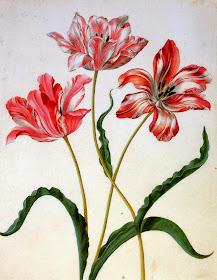But let
Maven of the Eventide tell you more about the film. Spoilers ahead, be warned.
The stunning costumes for the film were designed by
Bina Daigeler, who you may know as the designer for Le Moine (2010), a French adaptation of
Matthew Lewis's The Monk. Sadly, the film was awful, but the costumes were gorgeous.
In Only Lovers Left Alive costumes play a pivotal role in setting up character arcs for our protagonists. Adam is a depressed and miserable. He lives a secluded life surrounded by his antic guitars and feels completely detached from the world around him. His color scheme is dark and heavy, with a little romanticism thrown in for good measure. After all, Marlowe says that he should have based Hamlet on Adam. (Yes, Christopher Marlowe is in it)
Eve, on the other hand, almost always wears white or a mix of some bright colors and ivory or pale yellow. Her outfits often have gold embroidery. She is vivacious, well, by vampire standards, curious and full of life. She is the ray of sunshine that shines into Adam's dismal world.
Unlike Adam, Eve goes into public and meets up with her vampire friends. And while Adam mopes around his Detroit home in a hundred-year-old dressing gown, Eve puts on her off-white outfit, covers her face with a white scarf and braves the dusty streets of Tangier.
Eve's style is the more fascinating one, no less because it has more fluidity than that of other characters. She can blend in with her environment and people around her. When she goes to visit Adam in Detroit, she begins to adopt his darker leisurely style of dress. Her clothes go from light and bright, to dark and heavy.
But when she's on her own, surrounded by books in Tangier, her colors are vivid and fabrics are sumptuous. Adam's existence is shabby, like his hundred-year-old robe, while Eve's life is full of color and texture.
Eve's vampire best friend is Christopher Marlowe, who according to the movie, had faked his own death and is the real author of all of Shakespeare's plays and sonnets. Eve is a book lover, so she naturally gravitates towards him. Marlowe's style is a combination of light and dark colors, and his wardrobe is clearly more old-fashioned than that of the lovers. He likes vests. Ah, a man after my own heart.
Finally, we come to Ava, Eve's little 'sister'. She is younger than all the rest of the vampire characters both in terms of her apparent physical age, and her vampire age. She is bratty, willful and prefers more youthful and modern fashions. Unlike subdued or block colors of the lovers, Ava goes for patterns. She is fearless and brash and has no problem combining polka tights with an orange and purple floral mini-dress.
Considering how much thought and effort went into creating beautiful and fitting costumes for all the characters, it's not at all surprising that Vogue used it for their
fashion inspiration spread. I, personally, think Eve's sense of style is absolutely flawless and hope to be at least half as effortlessly chic as she is. Though I may have to become a vampire to achieve that.
The film is definitely worth watching, though it may seem a little slow-paced to some who are used to more plot-driven cinema. The vampire mythos is quite curious in this one. Garlic and going into houses uninvited do not carry all that much weight with these vampires, but drinking contaminated blood is dangerous.
The 'contaminated blood' issue did bother me a bit. I assume it refers to alcohol, drugs, disease and such. But if this is something vampires have a problem with, how did they survive the 16th century when everyone was dying of the Plague or syphilis and drinking nothing but alcohol. And the constant references to the
Marlovian Theory of authorship were a little on the nose. Still, this film feels remarkably fresh and enjoyable, no less thanks to Swinton
and Hiddleston, who give a great performance.
Image sources:


+The+Little+Foot+Page,+1905.++The+story+of+Burd+Helen+from+Scottish+balladry,+who+dressed+as+a+boy+page+to+follow+her+lover+on+foot+while+he+rode+on+horseback..jpg)





.jpg)






